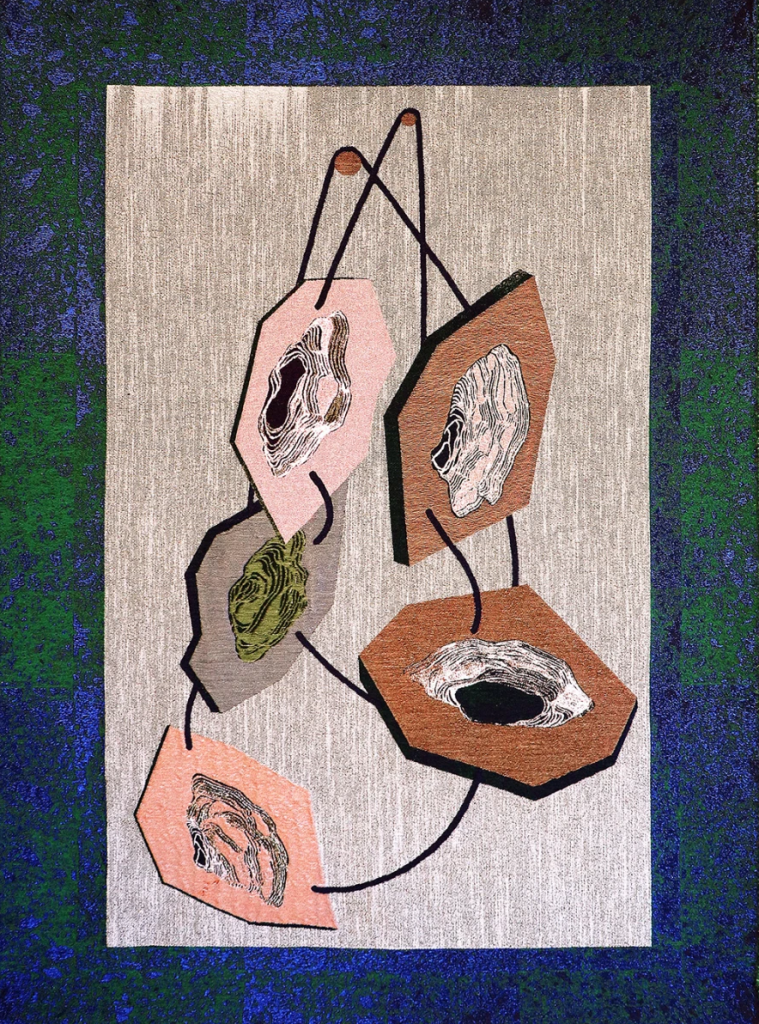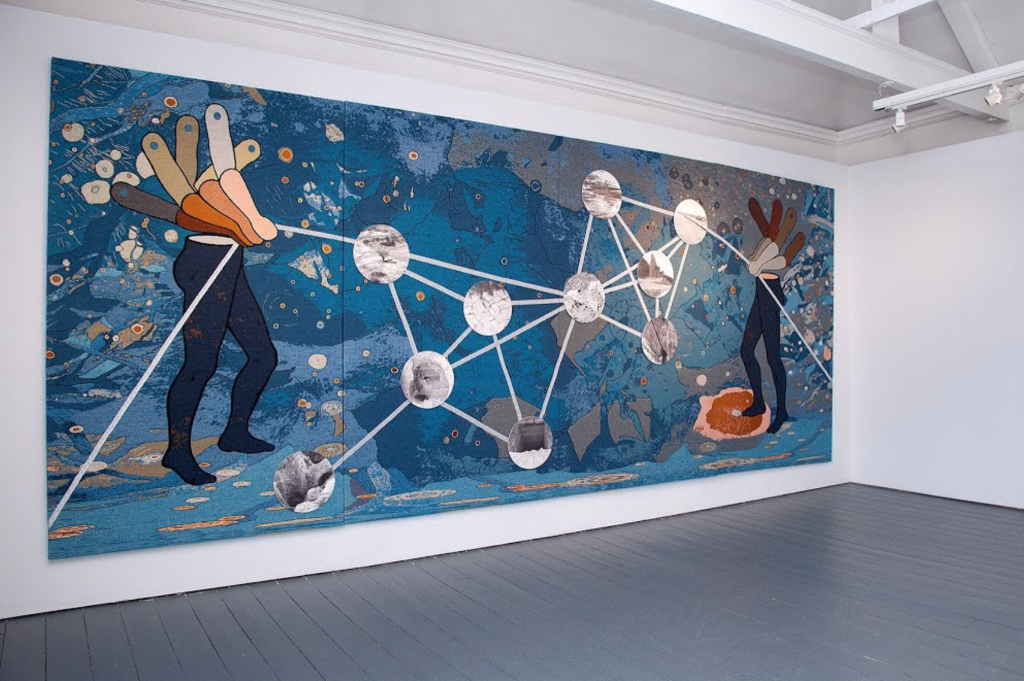#MeetTheArtist Otobong Nkanga
During Art Rotterdam, you can spot the work of hundreds of artists from all over the world. In this series we highlight a number of artists who will show remarkable work during the fair.
Otobong Nkanga wrote a poem for her last solo exhibition in Bregenz, Austria. She performed it as a clay tablet. In keeping with an exhibition that revolves, among other things, on the different manifestations of water and earth.
The reason Nkanga wrote a poem is that she doesn't like writing texts explaining her work. “I don't normally like writing texts about my work, but if you'd want me to explain my work then read a poem. What poetry does is to activate the emotions. To amplify the thoughts and to go beyond the language of politics and economy.”
Beyond the political and economic
Bypassing the political and economic language in order to address the viewer directly on an emotional level, that is in a nutshell what the multidisciplinary artist Otobong Nkanga (1974) aims at with her work. Through her wall hangings, drawings, video works, photography, installations and performances, she discusses almost every major topic of our time: think of the climate crisis, the extraction and distribution of raw materials and sustainability.
In doing so, she has an eye for both the places where the raw materials end up and the places that usually remain out of the picture: the parts of the world where raw materials are mined. The latter areas often coincide with former colonies, such as in West Africa, where the consequences of the colonial and current Western presence continue to affect societies to this day. “It’s important for me to work on the correlation of worlds that are visible to worlds that are not. My works move between the non-visible and the nontangible to places that are concrete, places that awaken the senses: touch, smell, sight, sound.”
Nkanga is considered one of the most important contemporary artists of African origin. Born in Kano, Nigeria, she grew up in France and lives and works in Antwerp. Her work was shown at the Venice Biennale (2019), documenta 14 (2017), and 14 Rooms in Basel (2014). In recent years, Nkanga has exhibited at the Gropius Bau in Berlin, Tate St Ives, Castello di Rivoli, and Kunsthaus Bregenz, among others.
Illustrative of her thinking is the answer she gave when asked what motivation means to her: “When you have a storm in Mozambique, that cleanses up a whole place. While some places are very turbulent, in others places it’s very calm, so you’re able to work and continue your life for 60 years. So to be able to be motivated is not entirely up to you. It is in the kind of environment and support that you get from people, places, landscape, weather, temperatures. All that makes it possible. I’ve been fortunate to have been in places where all those things align.” Where in the Western narrative everything begins and ends with the individual, Nkanga starts by taking into account environmental factors.

The Weight of Scars
In her work she shows the global interaction between these variables. You could therefore regard Nkanga's work as a poetic system analysis - one with a glimmer of hope. A recurring theme in her work is the extraction of raw materials - such as mica, a raw material that is used in make-up, among other things - and its worldwide implications.

Nkanga made the tapestry The Weight of Scars in 2015 after a visit to the Tsumeb mines in Namibia. On the installation you see two headless figures on either side who seem to have a sticks in their hands connected to 9 photos of mine shafts, holes, pipelines and explosions.
Nkanga found it difficult to look at the gaps in the landscape. As she walked into the old mine shafts, she thought of the scars and trauma people must have suffered here and the wounds in the landscape the mine caused. “While I was there, I realized that Tsumeb looked like this due to the use of explosives by the German colonial overlords. By doing so they have not only accelerated the method of mining, but also permanently changed the fabric of society.”
According to Nkanga, our insatiable appetite for consumer goods such as telephones, computers and make-up has made us addicted to raw materials such as copper, gold and mica. Yet, if we realize that we are all connected through these raw materials, we can interact with our landscape and each other in a different way, according to Nkanga.

Courtesy of the artist © Otobong Nkanga, Kunsthaus Bregenz
Unearthed
For Unearthed, the solo exhibition at Kunsthaus Bregenz last winter, Nkanga was given access to all 4 floors of the museum. She installed a tapestry on each floor of the museum showing one of the ways earth and water are intertwined. From the depths of the ocean, to the seasons, and the scorching heat of the sunlight in the desert, where plants grow despite the heat. As if nature always finds a way to carry on.
In addition, she had a tree stump installed on every floor between the floor and the ceiling. The slowly drying tree stump represents the gradual change. You cannot see the gradual but certain death of the tree, but there are signs from which the visitor can infer this. Call it an incentive to critically reflect on how we deal with our planet.
On the third floor, cables run from the dying stump to three glass capsules containing cuttings. In an interview, Nkanga says that tree was already nominated to be cut down, because it overshadowed other trees, preventing them from growing. Sometimes leaving a hole isn't bad. Still, one Nkanga decided to plant new trees elsewhere so as not to burden the local ecosystem too much.
To celebrate the Kunsthaus's 25th anniversary, the museum has rented the 16th-century Scuola di San Pasquale during the Venice Biennale to draw attention to its forward-thinking exhibition program. In addition to a presentation of work by Anna Boghiguian, the Kunsthaus shows work by Otobong Nkanga.
Tied to the other side
At the upcoming edition of Art Rotterdam, the Lumen Travo gallery will show a new tapestry that has never been on display before. Tied to the other side measures 3.5 x 6.5 meters and was woven according to Nkanga's specifications and drawings by the Tilburg Textile Lab on the recently purchased Dornier loom. This is a state-of-the-art loom that can handle complex patterns and structures and can weave rugs up to three and a half meters wide.

Courtesy of the artist © Otobong Nkanga, Kunsthaus Bregenz
Tied to the other Side is about how we deal with the elements of earth and water. Our appetite for raw materials has taken on such forms that drilling is also taking place in deeper places in the sea. On the blue tapestry we see this craving take on the shape of a scaffold-like structure with arms, plants and a container attached to it, and in the shape of a needle that pricks a human body. The needle represents the machinery and system that exploits people, land and sea. On the left you see a number of staffs. One of those staffs emits bright rays that indicate as yet unknown possibilities. Rays projecting into the future.


